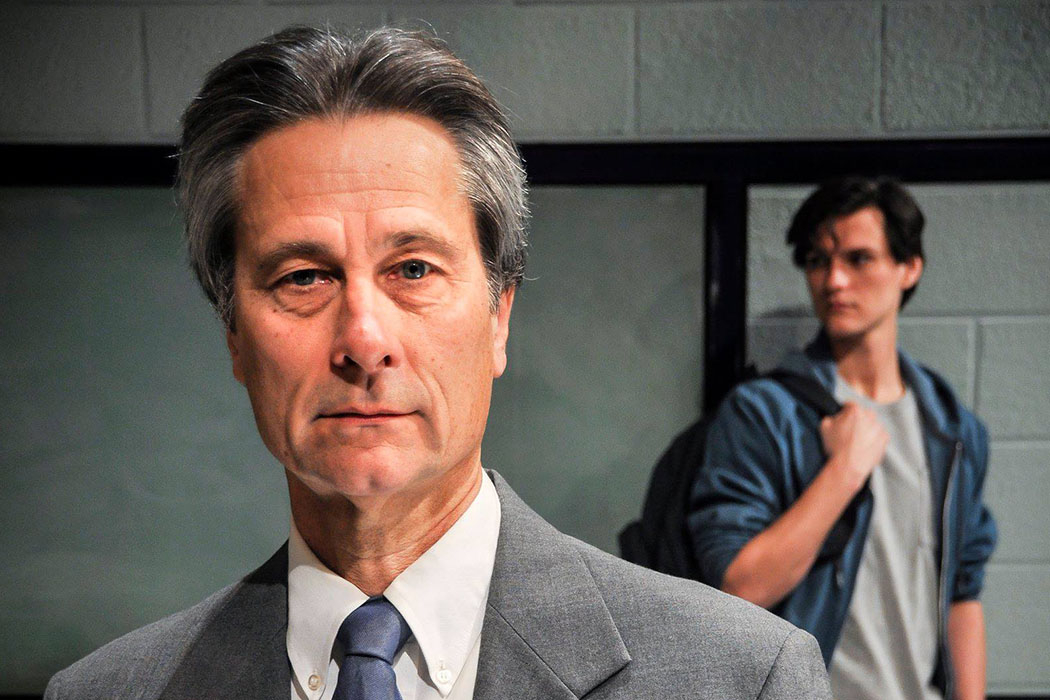Our perception of David West Read’s play, The Dream of the Burning Boy, in current production at Clarence Brown Theatre’s Lab Theatre, might have been quite different without the tragic mass shooting at Marjory Stoneman Douglas High School in Parkland, Florida, this past February 14. That shooting, and the subsequent aftermath of physical and psychological trauma suffered by students, parents, and teachers, have—at least for the short term—redefined the public’s standard of grief and anger around such tragedies. Theatre, though, does not exist in a vacuum. As a result, the premise of Read’s play—the grief and anger of students and faculty in a high school when a popular student inexplicably drops dead of a brain aneurism—seems a bit simplistic given the unavoidable comparisons to current events.
Fortunately, director Carol Mayo Jenkins has brilliantly coaxed every last ounce of plausibility out of Read’s script, aided by a terrific faculty/student cast with the key being the creation of specific personalities, each with varying layers of depth. In addition, Jenkins has carried an inventive attitude over into the production itself, maintaining a sleek style set off by rhythm and pace, not just in the scenes, but also in the choreographed scene changes.
UT Theatre faculty member Terry Weber portrays English teacher Larry Morrow who was meeting with the student, Dane (Ben Terpstra), just prior to his collapse outside the classroom in the hallway. In the aftermath of the death, Larry, secretly dealing with his own reason for grief, is confronted with the shallow efforts of the school to deal with the tragedy. Of course, along with expected trite encouragements to “talk about it,” there are the laughingly superficial gestures like posters, assemblies, and stuffed animals, all promoted by the school’s guitar-strumming guidance counselor, Steve (Mark Jennings).
At first, Larry refuses Steve’s largely incompetent—and irritating—efforts at grief management, but slowly allows dribs and drabs of emotion to percolate to the surface of his severely muted personality. While napping at his desk, Larry mutters “Dane” in his sleep, something that Steve overhears and takes as a license to urge Larry to discuss his grief.
In contrast to Larry, the other students react to the tragedy with quite different emotions. Dane’s sister, Rachel (Alyssa Miller), is bitter on multiple levels, not only sarcastically attacking the school’s efforts at grief management, but also Dane’s girlfriend, Chelsea (Chauncey Whitlock). Rachel is by far Read’s most complex character on the surface, charged with showing an arc of dawning awareness, while incrementally revealing her own vulnerabilities.
Chelsea finds herself caught in the middle of how to react, whether with grief for the death or with conscience having taken up with Dane’s friend Kyle (Brady Moldrup). While Whitlock did an admirable job of exploring what there is of the character’s depth, the playwright could have offered her more to work with.
Katie Cunningham, last seen in February’s CBT production of Alabama Story, portrays Andrea, the mother of Rachel and Dane. The character appears in but one scene in which she meets with Larry in the guidance counselor’s office, but it is a scene that is pivotal to understanding both characters and in which direction the play is headed. Cunningham paints her Andrea as a woman who is physical and “suburban-sensual” yet vulnerable, qualities that are placed in direct contrast to Larry’s seemingly emotionless demeanor. It is through Andrea that we understand what this contrasting ability—or inability—to act has meant to each of their pasts. In the end, though, it is the tragedy of Larry alone that the audience must consider—the tragedy belonging to those who have shielded themselves from the corrosive guilt of missed opportunities by retreating into a safe place.
In the confining space of the CBT Lab Theatre, scenic designer Jelena Andzic has devised a clever set of flipping panels that reveal different variations of cinderblock walls and bookcases that move the play from room to room within the high school. Lighting designer Alice Trent succeeded in creating a dramatic atmosphere and a schoolroom look without actually being featurelessly flat. Costume designer Kate Cannon nailed the high school attitude and a few visual metaphors, from effortless casual clothes for Rachel, to bland attire for Larry, to sensuality-revealing casual clothes for Andrea.
The Dream of the Burning Boy runs in the Clarence Brown Theatre’s Lab Theatre through April 15.








